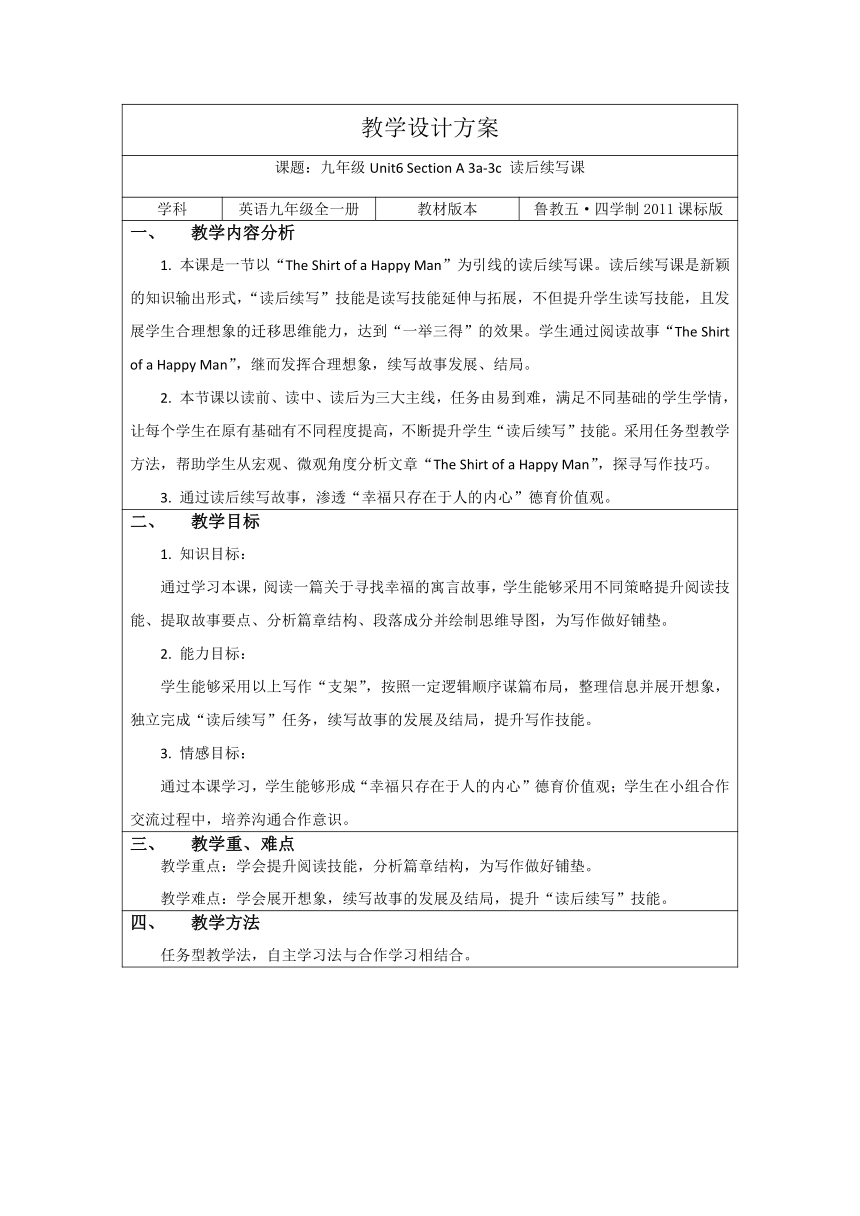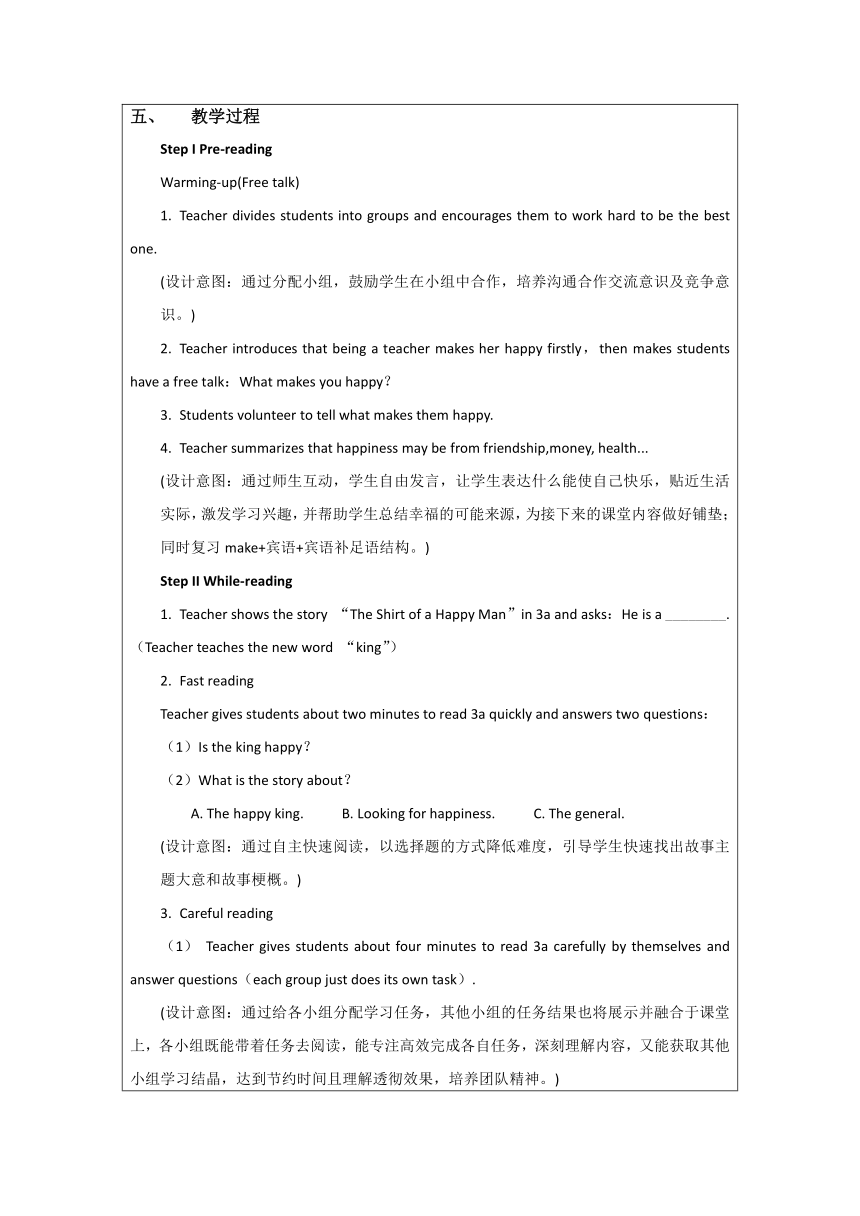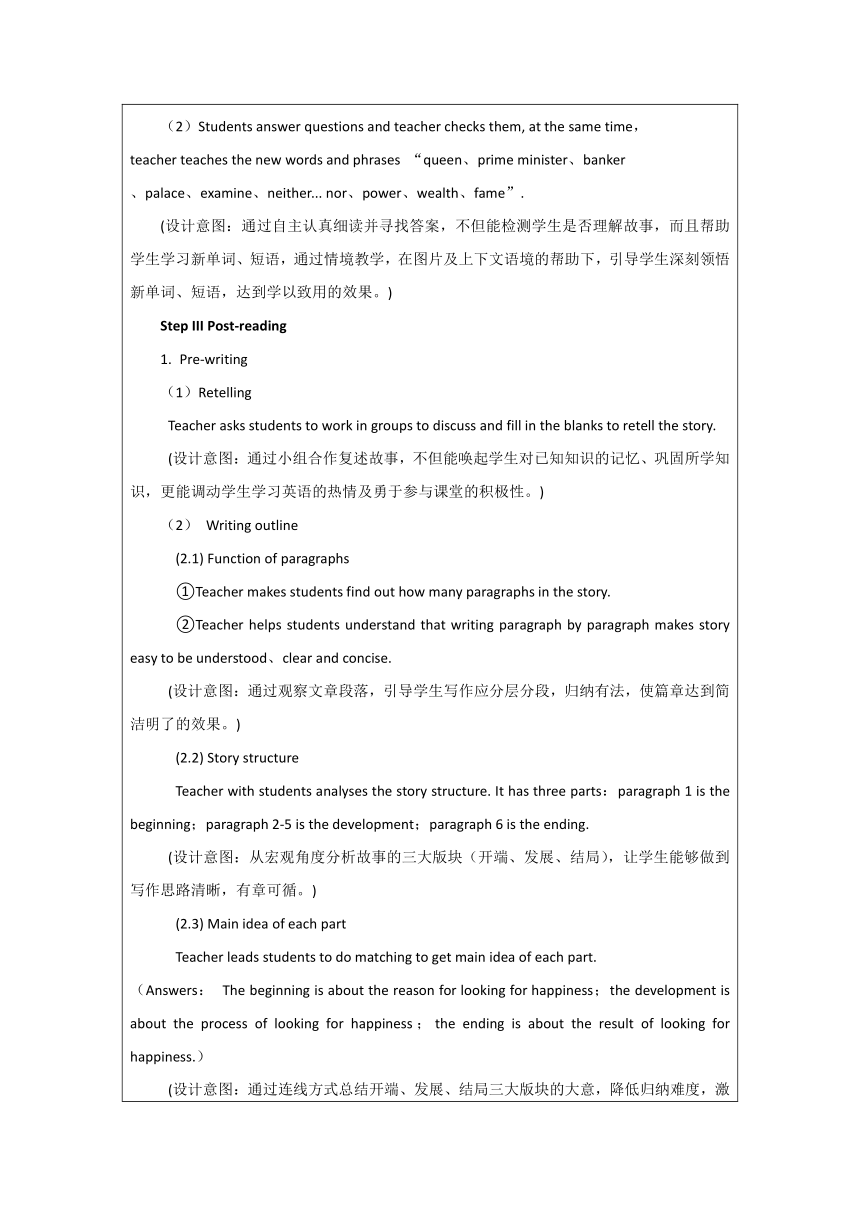鲁教(五四)版九年级全册 Unit6 Sad movies make me cry. SectionA 3a-3c 读后续写课教案(表格式)
文档属性
| 名称 | 鲁教(五四)版九年级全册 Unit6 Sad movies make me cry. SectionA 3a-3c 读后续写课教案(表格式) |  | |
| 格式 | doc | ||
| 文件大小 | 69.0KB | ||
| 资源类型 | 教案 | ||
| 版本资源 | 鲁教版 | ||
| 科目 | 英语 | ||
| 更新时间 | 2022-10-09 07:09:55 | ||
图片预览



文档简介
教学设计方案
课题:九年级Unit6 Section A 3a-3c 读后续写课
学科 英语九年级全一册 教材版本 鲁教五·四学制2011课标版
教学内容分析本课是一节以“The Shirt of a Happy Man”为引线的读后续写课。读后续写课是新颖的知识输出形式,“读后续写”技能是读写技能延伸与拓展,不但提升学生读写技能,且发展学生合理想象的迁移思维能力,达到“一举三得”的效果。学生通过阅读故事“The Shirt of a Happy Man”,继而发挥合理想象,续写故事发展、结局。本节课以读前、读中、读后为三大主线,任务由易到难,满足不同基础的学生学情,让每个学生在原有基础有不同程度提高,不断提升学生“读后续写”技能。采用任务型教学方法,帮助学生从宏观、微观角度分析文章“The Shirt of a Happy Man”,探寻写作技巧。通过读后续写故事,渗透“幸福只存在于人的内心”德育价值观。
教学目标知识目标:通过学习本课,阅读一篇关于寻找幸福的寓言故事,学生能够采用不同策略提升阅读技能、提取故事要点、分析篇章结构、段落成分并绘制思维导图,为写作做好铺垫。能力目标:学生能够采用以上写作“支架”,按照一定逻辑顺序谋篇布局,整理信息并展开想象,独立完成“读后续写”任务,续写故事的发展及结局,提升写作技能。情感目标:通过本课学习,学生能够形成“幸福只存在于人的内心”德育价值观;学生在小组合作交流过程中,培养沟通合作意识。
教学重、难点教学重点:学会提升阅读技能,分析篇章结构,为写作做好铺垫。教学难点:学会展开想象,续写故事的发展及结局,提升“读后续写”技能。
教学方法 任务型教学法,自主学习法与合作学习相结合。
教学过程Step I Pre-readingWarming-up(Free talk)Teacher divides students into groups and encourages them to work hard to be the best one.(设计意图:通过分配小组,鼓励学生在小组中合作,培养沟通合作交流意识及竞争意识。)Teacher introduces that being a teacher makes her happy firstly,then makes students have a free talk:What makes you happy?Students volunteer to tell what makes them happy.Teacher summarizes that happiness may be from friendship,money, health...(设计意图:通过师生互动,学生自由发言,让学生表达什么能使自己快乐,贴近生活实际,激发学习兴趣,并帮助学生总结幸福的可能来源,为接下来的课堂内容做好铺垫;同时复习make+宾语+宾语补足语结构。)Step II While-readingTeacher shows the story “The Shirt of a Happy Man”in 3a and asks:He is a ________.(Teacher teaches the new word “king”)Fast readingTeacher gives students about two minutes to read 3a quickly and answers two questions:(1)Is the king happy?(2)What is the story about?A. The happy king. B. Looking for happiness. C. The general.(设计意图:通过自主快速阅读,以选择题的方式降低难度,引导学生快速找出故事主题大意和故事梗概。)Careful readingTeacher gives students about four minutes to read 3a carefully by themselves and answer questions(each group just does its own task).(设计意图:通过给各小组分配学习任务,其他小组的任务结果也将展示并融合于课堂上,各小组既能带着任务去阅读,能专注高效完成各自任务,深刻理解内容,又能获取其他小组学习结晶,达到节约时间且理解透彻效果,培养团队精神。)(2)Students answer questions and teacher checks them, at the same time,teacher teaches the new words and phrases “queen、prime minister、banker、palace、examine、neither... nor、power、wealth、fame”.(设计意图:通过自主认真细读并寻找答案,不但能检测学生是否理解故事,而且帮助学生学习新单词、短语,通过情境教学,在图片及上下文语境的帮助下,引导学生深刻领悟新单词、短语,达到学以致用的效果。)Step III Post-readingPre-writing (1)Retelling Teacher asks students to work in groups to discuss and fill in the blanks to retell the story. (设计意图:通过小组合作复述故事,不但能唤起学生对已知知识的记忆、巩固所学知识,更能调动学生学习英语的热情及勇于参与课堂的积极性。)Writing outline(2.1) Function of paragraphs①Teacher makes students find out how many paragraphs in the story.②Teacher helps students understand that writing paragraph by paragraph makes story easy to be understood、clear and concise. (设计意图:通过观察文章段落,引导学生写作应分层分段,归纳有法,使篇章达到简洁明了的效果。)(2.2) Story structureTeacher with students analyses the story structure. It has three parts:paragraph 1 is the beginning;paragraph 2-5 is the development;paragraph 6 is the ending. (设计意图:从宏观角度分析故事的三大版块(开端、发展、结局),让学生能够做到写作思路清晰,有章可循。)(2.3) Main idea of each partTeacher leads students to do matching to get main idea of each part.(Answers: The beginning is about the reason for looking for happiness;the development is about the process of looking for happiness;the ending is about the result of looking for happiness.) (设计意图:通过连线方式总结开端、发展、结局三大版块的大意,降低归纳难度,激发学生持续学习的兴趣。)(2.4) Content of paragraphs Teacher takes the third paragraph as an example to help students know what a paragraph includes. (Answers: It includes person、 place、 past tense (verb)、 what he has、 what he doesn’t have and reason、 present tense (verb) in self exposition.) (设计意图:通过分析段落包含的内容,帮助学生明白:写作应以此为据,大胆丰富段落内容,让文章饱满,有内容可读。) (2.5) Mind mapping Teacher shows the writing outline of the story according to mind mapping. (设计意图:通过思维导图,帮助学生从宏观角度总悟写作框架,了解写作要素,帮助学生增强写作逻辑性,使语篇结构更严谨,提高写作水平。)(3) Sample writingTeacher shows a sample writing and asks students to read aloud to get more information if necessary. (设计意图:通过例文,引导学生从中领悟写作的模式与精髓,激发学生的迁移思维,打开思维,为接下来的自主“读后续写”做好充足的准备。)While-writingTeacher gives students about five minutes to continue the story,they can use the mind mapping in 3a and other information shown on the screen. (设计意图:通过读后续写的方式检查学生学的质量,引导学生运用篇章结构、思维导图、段落内容并发挥合理想象预测故事的发展及结局,进行新颖的语言实践输出,提高学生学习效率并培养学生的想象力,使他们积极参与写作,表达自己的想法。)3.Post-writing(3.1) Teacher makes students work with other members in other groups step by step like following:(Step 1. Collect and exchange writings with members in another group ;Step 2. Read aloud and correct mistakes using red pen;Step 3. Work together to choose the best writing.) (设计意图:通过与异组交换作品,使学生的组内合作扩展到异组合作,更大限度达到相互学习效果,再次培养学生团队合作交流意识;通过边读边改,领略他人作品风采并避免重复出现他人的失误,以提高写作水平;最后,学生共同探讨择一篇优秀作文,人人各抒己见,思维碰撞出火花,体现学生主体作用。)(3.2) Teacher shares different kinds of stories in the front of class on screen with students and analyses the key information from them. (设计意图:通过展示故事,让全班学生互相了解不同的幸福观。)Step IV. Affective educationTeacher helps students get the affective education: A person happy or not has nothing to do with the external factors such as power, money, the key is their own state of mind. (设计意图:通过渗透德育教育,学生能够形成“幸福只存在于人的内心”德育价值观,达到情感升华的作用。)Teacher counts the scores every groups gets and praises the best group which gets the high scores. Then Teacher advises students to applause them. When teachers finds that the members who in the best group are smiling, teacher will say: They are happy now,they get happiness from success or just from doing better in class. (设计意图:通过结算各组总分,当众表扬最优一组,对本堂课学生的表现进行及时反馈,让学生的学习意义得到最大展现。当获胜一组组员展现欢喜时,教师及时抓取欢喜瞬间并提示他们的幸福来源于课堂的成功,达到点题的效果。)Teacher shares three secrets about how to be happy in our daily life. (设计意图:通过分享快乐的秘诀,让学生在学习知识的同时也能够在实际生活中获取幸福,达到学以致用的效果。)
板书设计
课题:九年级Unit6 Section A 3a-3c 读后续写课
学科 英语九年级全一册 教材版本 鲁教五·四学制2011课标版
教学内容分析本课是一节以“The Shirt of a Happy Man”为引线的读后续写课。读后续写课是新颖的知识输出形式,“读后续写”技能是读写技能延伸与拓展,不但提升学生读写技能,且发展学生合理想象的迁移思维能力,达到“一举三得”的效果。学生通过阅读故事“The Shirt of a Happy Man”,继而发挥合理想象,续写故事发展、结局。本节课以读前、读中、读后为三大主线,任务由易到难,满足不同基础的学生学情,让每个学生在原有基础有不同程度提高,不断提升学生“读后续写”技能。采用任务型教学方法,帮助学生从宏观、微观角度分析文章“The Shirt of a Happy Man”,探寻写作技巧。通过读后续写故事,渗透“幸福只存在于人的内心”德育价值观。
教学目标知识目标:通过学习本课,阅读一篇关于寻找幸福的寓言故事,学生能够采用不同策略提升阅读技能、提取故事要点、分析篇章结构、段落成分并绘制思维导图,为写作做好铺垫。能力目标:学生能够采用以上写作“支架”,按照一定逻辑顺序谋篇布局,整理信息并展开想象,独立完成“读后续写”任务,续写故事的发展及结局,提升写作技能。情感目标:通过本课学习,学生能够形成“幸福只存在于人的内心”德育价值观;学生在小组合作交流过程中,培养沟通合作意识。
教学重、难点教学重点:学会提升阅读技能,分析篇章结构,为写作做好铺垫。教学难点:学会展开想象,续写故事的发展及结局,提升“读后续写”技能。
教学方法 任务型教学法,自主学习法与合作学习相结合。
教学过程Step I Pre-readingWarming-up(Free talk)Teacher divides students into groups and encourages them to work hard to be the best one.(设计意图:通过分配小组,鼓励学生在小组中合作,培养沟通合作交流意识及竞争意识。)Teacher introduces that being a teacher makes her happy firstly,then makes students have a free talk:What makes you happy?Students volunteer to tell what makes them happy.Teacher summarizes that happiness may be from friendship,money, health...(设计意图:通过师生互动,学生自由发言,让学生表达什么能使自己快乐,贴近生活实际,激发学习兴趣,并帮助学生总结幸福的可能来源,为接下来的课堂内容做好铺垫;同时复习make+宾语+宾语补足语结构。)Step II While-readingTeacher shows the story “The Shirt of a Happy Man”in 3a and asks:He is a ________.(Teacher teaches the new word “king”)Fast readingTeacher gives students about two minutes to read 3a quickly and answers two questions:(1)Is the king happy?(2)What is the story about?A. The happy king. B. Looking for happiness. C. The general.(设计意图:通过自主快速阅读,以选择题的方式降低难度,引导学生快速找出故事主题大意和故事梗概。)Careful readingTeacher gives students about four minutes to read 3a carefully by themselves and answer questions(each group just does its own task).(设计意图:通过给各小组分配学习任务,其他小组的任务结果也将展示并融合于课堂上,各小组既能带着任务去阅读,能专注高效完成各自任务,深刻理解内容,又能获取其他小组学习结晶,达到节约时间且理解透彻效果,培养团队精神。)(2)Students answer questions and teacher checks them, at the same time,teacher teaches the new words and phrases “queen、prime minister、banker、palace、examine、neither... nor、power、wealth、fame”.(设计意图:通过自主认真细读并寻找答案,不但能检测学生是否理解故事,而且帮助学生学习新单词、短语,通过情境教学,在图片及上下文语境的帮助下,引导学生深刻领悟新单词、短语,达到学以致用的效果。)Step III Post-readingPre-writing (1)Retelling Teacher asks students to work in groups to discuss and fill in the blanks to retell the story. (设计意图:通过小组合作复述故事,不但能唤起学生对已知知识的记忆、巩固所学知识,更能调动学生学习英语的热情及勇于参与课堂的积极性。)Writing outline(2.1) Function of paragraphs①Teacher makes students find out how many paragraphs in the story.②Teacher helps students understand that writing paragraph by paragraph makes story easy to be understood、clear and concise. (设计意图:通过观察文章段落,引导学生写作应分层分段,归纳有法,使篇章达到简洁明了的效果。)(2.2) Story structureTeacher with students analyses the story structure. It has three parts:paragraph 1 is the beginning;paragraph 2-5 is the development;paragraph 6 is the ending. (设计意图:从宏观角度分析故事的三大版块(开端、发展、结局),让学生能够做到写作思路清晰,有章可循。)(2.3) Main idea of each partTeacher leads students to do matching to get main idea of each part.(Answers: The beginning is about the reason for looking for happiness;the development is about the process of looking for happiness;the ending is about the result of looking for happiness.) (设计意图:通过连线方式总结开端、发展、结局三大版块的大意,降低归纳难度,激发学生持续学习的兴趣。)(2.4) Content of paragraphs Teacher takes the third paragraph as an example to help students know what a paragraph includes. (Answers: It includes person、 place、 past tense (verb)、 what he has、 what he doesn’t have and reason、 present tense (verb) in self exposition.) (设计意图:通过分析段落包含的内容,帮助学生明白:写作应以此为据,大胆丰富段落内容,让文章饱满,有内容可读。) (2.5) Mind mapping Teacher shows the writing outline of the story according to mind mapping. (设计意图:通过思维导图,帮助学生从宏观角度总悟写作框架,了解写作要素,帮助学生增强写作逻辑性,使语篇结构更严谨,提高写作水平。)(3) Sample writingTeacher shows a sample writing and asks students to read aloud to get more information if necessary. (设计意图:通过例文,引导学生从中领悟写作的模式与精髓,激发学生的迁移思维,打开思维,为接下来的自主“读后续写”做好充足的准备。)While-writingTeacher gives students about five minutes to continue the story,they can use the mind mapping in 3a and other information shown on the screen. (设计意图:通过读后续写的方式检查学生学的质量,引导学生运用篇章结构、思维导图、段落内容并发挥合理想象预测故事的发展及结局,进行新颖的语言实践输出,提高学生学习效率并培养学生的想象力,使他们积极参与写作,表达自己的想法。)3.Post-writing(3.1) Teacher makes students work with other members in other groups step by step like following:(Step 1. Collect and exchange writings with members in another group ;Step 2. Read aloud and correct mistakes using red pen;Step 3. Work together to choose the best writing.) (设计意图:通过与异组交换作品,使学生的组内合作扩展到异组合作,更大限度达到相互学习效果,再次培养学生团队合作交流意识;通过边读边改,领略他人作品风采并避免重复出现他人的失误,以提高写作水平;最后,学生共同探讨择一篇优秀作文,人人各抒己见,思维碰撞出火花,体现学生主体作用。)(3.2) Teacher shares different kinds of stories in the front of class on screen with students and analyses the key information from them. (设计意图:通过展示故事,让全班学生互相了解不同的幸福观。)Step IV. Affective educationTeacher helps students get the affective education: A person happy or not has nothing to do with the external factors such as power, money, the key is their own state of mind. (设计意图:通过渗透德育教育,学生能够形成“幸福只存在于人的内心”德育价值观,达到情感升华的作用。)Teacher counts the scores every groups gets and praises the best group which gets the high scores. Then Teacher advises students to applause them. When teachers finds that the members who in the best group are smiling, teacher will say: They are happy now,they get happiness from success or just from doing better in class. (设计意图:通过结算各组总分,当众表扬最优一组,对本堂课学生的表现进行及时反馈,让学生的学习意义得到最大展现。当获胜一组组员展现欢喜时,教师及时抓取欢喜瞬间并提示他们的幸福来源于课堂的成功,达到点题的效果。)Teacher shares three secrets about how to be happy in our daily life. (设计意图:通过分享快乐的秘诀,让学生在学习知识的同时也能够在实际生活中获取幸福,达到学以致用的效果。)
板书设计
同课章节目录
- Unit 1 When was it invented?
- Section A
- Section B
- Unit 2 Teenagers should be allowed to choose their
- Section A
- Section B
- Unit 3 It must belong to Carla.
- Section A
- Section B
- Unit 4 I like music that I can dance to.
- Section A
- Section B
- Unit 5 You’re supposed to shake hands.
- Section A
- Section B
- Unit 6 Sad movies make me cry.
- Section A
- Section B
- Unit 7 Life is full of the unexpected.
- Section A
- Section B
- Unit 8 We're trying to save the earth!
- Section A
- Section B
- Unit 9 It's important to have good habits.
- Section A
- Section B
- Unit 10 I remember meeting all of you in Grade 6.
- Section A
- Section B
